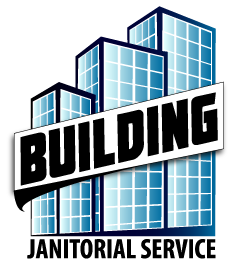Stripping a vinyl floor is one of the janitorial services Building Janitorial Service has been providing to area businesses since 1984. This article explains how the crew strips a vinyl floor, and is not intended to be a recommendation to any person to use or rely upon this information when stripping a floor. Building Janitorial Service can not be held liable for any consequences, damage, or injury to any property or to any person who uses or relies upon the information in this article if they strip or scrub a floor.
The following equipment, chemical, and supplies are required: slow speed electric buffer, attachable drive pad, black polyester scrubbing pad, stripper (stripping chemical), wet vacuum, mop, bucket, and wringer, mixing pail, and paper towels.
The buffer is set up on the opposite end of the building from the exit door, and the furniture and other objects are removed from the floor. The stripper is mixed with water according to the directions on the back of the gallon jug. It is mixed with tap water, not hot. It is the chemical that does the work, not the temperature of the water. A half inch coat of solution is poured and spread evenly on the floor, wiping up any overspill on the baseboards, the walls, the doors, and the window sills. Twenty minutes is allowed to pass, so the chemical has time to work. If parts of the solution begin to dry before the twenty minutes are up, additional stripper solution is reapplied on the dry spots.
Twenty minutes after the initial stripper solution was put down, the floor is scrubbed with the buffer using the black pad under the drive pad of the machine. The floor is slippery at this time, so the crew must be careful not to slip. The crew wears neoprene or rubber shoes for additional traction.
The machine operator must be careful not to get the cord caught in the drive pad or around the drive pad locking clamp. If the cord gets caught in the drive pad or around the locking clamp, the drive pad will stop rotating and freeze or lock up. The machine operator could lose control, and the machine could go through a wall and damage other building contents. The machine operator could be injured.
The machine operator must also be careful not to hit the baseboards with the buffer when scrubbing the floor, because it will leave a mark on the baseboards.
The cord of the buffer will be in the solution on the floor so if the cord is damaged and has exposed copper wire, the cord is replaced before the floor is stripped. A live exposed copper wire lying in solution on a floor could shock the machine operator, who is standing in the solution on the wet floor, when he or she turns on the electric switch on the buffer. And an exposed live copper wire lying in solution on the floor could shock the machine operator, who is standing in the solution on the floor, when he or she inserts the plug of the electric buffer into the wall socket.
After scrubbing the floor, the soiled solution is sucked up with a wet vacuum. The floor is then rinsed by mopping it with clear water. It is mopped until the rinse water in the bucket remains clear after the mop head is wrung out. When the floor dries, it is ready to be waxed by the crew of the janitorial service.
